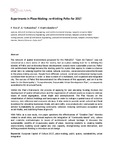| dc.description.abstract | The network of spatial interventions proposed for the Pafos2017 “Open Air Factory” was not conceived as a mere series of sites for events, but as a place-making tool for re-defining the identity of Pafos and re-directing future development towards more sustainable practices. Pafos’ rich architectural heritage became the starting point for a plan that aspires to create a cohesive urban fabric by weaving together the spatial, cultural, economic, social and environmental threads in the place-making process. People from different cultural, social and professional backgrounds combined their expertise in order to draw a vision of a revitalized, well-organized and integrated city. The success of Pafos’ Bid demonstrated the effectiveness of this approach, and set it as the basis for the Municipality’s “Comprehensive, Sustainable Urban Development Plan”, consequently submitted to EU structural Funds.
Within the Plan’s framework, the process of applying for and allocating funding involves the development of spatial infrastructure and the organization of cultural events as means to address issues of social segregation, urban blight and unemployment. The Plan focuses on the rehabilitation of distinct buildings and landscapes in order to reshape a spatial nexus of collective memory, civic reference and economic vibrancy. It also seeks to provide social, cultural and fiscal incentives for relocating businesses (trade, arts and crafts, local products etc.) and people so as to achieve Sustainability by preserving community cohesion, inducing continuous occupation and social vitality, and stabilizing financial growth.
With Pafos as a case study, the paper questions the effectiveness of “Creative-Class” theories related to small cities, and instead explores the integration of “Community-based” arts, culture and creativity methodologies in issues of architectural cultural heritage. It discusses the sustainability benefits of re-purposing assets of place, involving residents in creating healthy environments, building social capital and civic capacity, strengthening social interaction, and shifting prevalent thinking to introduce social change. | en_UK |


